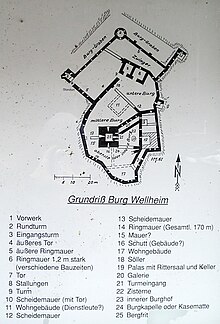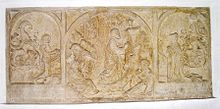Wellheim Castle
| Wellheim Castle | ||
|---|---|---|
| Creation time : | 12th Century | |
| Castle type : | Höhenburg, rocky location | |
| Conservation status: | ruin | |
| Construction: | Hunchback cuboid, limestone, half-timbering | |
| Place: | Wellheim | |
| Geographical location | 48 ° 49 '14.5 " N , 11 ° 4' 48.8" E | |
|
|
||
The Wellheim Castle is a former military facility in Upper Bavaria ( Eichstätt ). The ruin of the rock castle is dominant on a Jura rock above the Wellheim market in the Urdonautal (Wellheimer dry valley). It was abandoned and partially demolished in the 18th century.
Access
The castle ruins above Wellheim can be reached via the district road EI 5 Wellheim - Gammersfeld , which branches off in the center of Wellheim after the town hall. Below the castle complex, the road leads through two tunnels carved into the castle rock. It was designed and built in 1921/22 by Emil Johannes Köhler (1870–1941), then head of the Wellheim-Süd building authority of the association for Jura access roads.
history
The Lords of Wellheim were first mentioned in a document with "Friedrich von Wellenhaym (nobilis homo)" in 1121 and were probably of noble origin. In competition with the up-and-coming Counts von Grögling and Dollnstein , who called themselves Counts von Hirschberg after their new castle , the Knights of Wellenheim gradually lost their property, but got their castle back as a fief. The formerly free lords of Wellenheim became ministerials .
When the last Hirschberger, Count Gebhard VII. Died in 1305, the rule was transferred to the Counts of Oettingen in 1309 as part of a settlement; the Wellheimer knights became Ottingian ministerials. A Raimund appeared in 1322 and Hans von Wellenheim in 1344 as the count's servants. The last of this family was Gößwein, Marshal von Wellenheim, who recorded this in 1400.
In 1360 Friedrich von Heydeck bought the castle from the Oettingern together with the Dollnstein family. Johann von Heydeck had to cede the castle and the associated property in 1449 as a "reparation payment" after a feud with the Margrave Achilles of Brandenburg-Ansbach and his allies, the Neuburg Count Palatine Otto and Johann von Heydeck. The margrave acquired the shares of his allies and gave the castle to his servant Hilpolyt von Seckendorf-Brunn as a fief.
In 1458 the rule was sold on to Count Konrad von Helfenstein , captain and governor of Monheim. Konrad lived in the castle temporarily with his wife and was also buried in Wellheim after his death. His epitaph has been preserved in the parish church of St. Andrew. In 1525, the former Helfenstein servant Zacharias Krell seized the castle by submitting false documents and became the chief leader of the farmers of Wellheim and the surrounding area in the peasant uprising . He barricaded the castle against the advancing Neuburgers, but was shot when he let himself be seen through a tower opening. With his death, the "Wellheim Peasants' War" also came to an end.
In 1627 the castle came to the Counts of Oettingen-Baldern by inheritance after Georg-Wilhelm von Helfenstein died in Venice without a male heir. The rule would now actually have reverted to Brandenburg-Ansbach. Since the Margraves of Ansbach were Protestants, the Catholic Duke Wolfgang Wilhelm von Pfalz-Neuburg tried to acquire the rule in order to maintain the Catholic faith there. To this end, the duke even wrote to the emperor on October 8, 1627. Although the Neuburger could not bring Wellheim into his possession, the Catholic Isabella Eleonore von Oettingen-Baldern, the daughter of the last Helfensteiner, was appointed chief heir. After the death of the heiress, her extravagant son Ferdinand sold his rights to the Ansbach margraves who paid homage to Wellheim on June 27, 1681.
As early as 1683, Wellheim was sold on to the Eichstätt Monastery for the payment of 40,000 guilders . The Count Palatine in Neuburg also had some possessions and hunting rights in the area. In order to prevent all disputes and problems, the Neuburg and Ansbach family decided to transfer ownership to Eichstätt.
The previous nursing office was downgraded to a nursing administrator's office under Prince-Bishop Marquard II. Schenk von Castell (ruled 1636–1685). The nurse was in Eichstätt, in Wellheim there was only one caretaker in the nursing home under the castle. The castle, which has only occasionally been inhabited by its owners since the end of the 16th century, began to suffer. Demolition began in 1767: the buildings were partially demolished and the curtain wall laid down. When the castle was no longer locked soon after 1773, everything that could be used was stolen. From the end of the 18th century the castle served as a quarry.
In 1796, the government in Ansbach demanded that the Wellheim rule be surrendered in return for a refund of the purchase price, in order to give it to the well-deserved Minister of State von Hardenberg. The Hochstift then threatened to file a lawsuit with the Reichsgericht. Because of the legal hopelessness, Brandenburg-Ansbach refrained from further attempts to regain Wellheim.
The secularization of 1802 brought the transition to the Electorate of Bavaria , which had to cede the rule to the Grand Duchy of Tuscany on December 26, 1802 .
Wellheim became Bavarian again as early as 1805 ( Peace of Pressburg ). In 1817 Eugène de Beauharnais , the son-in-law of the sovereign Max Josef , was appointed Duke of Leuchtenberg and received the secularized Hochstift Eichstätt as a principality . In 1833 his son 'Duke August von Leuchtenberg sold his rights to Bavaria again. The rulership court in Eichstätt was converted into a royal Bavarian regional court, 1st class. In 1837 the district court came to the newly formed district of Middle Franconia . Since the regional reform in 1972, the district of Eichstätt and thus Wellheim has belonged to Upper Bavaria.
In 1935, inmates of the Rebdorf workhouse near Eichstätt had to close the gaps in the wall of the keep. In 1964/67 the castle was secured, later some minor conservation measures and exposures were carried out.
description
The Romanesque upper castle was laid out in a spectacular location on a wildly rugged rock formation above the Wellheim market. From Palas and other buildings in the inner castle only parts of the outer walls and remains of walls have been preserved. The hall was in the east, and a söller formed the connection to a residential building in the south. In the north the mighty, square keep rises up from regular humpback ashlars with edging. The approximately 35-meter-high tower is closed by a later upper floor made of brick (arched window openings), which formerly had a gable roof. The original conclusion was a crenellated wreath, which is still clearly visible from the masonry. The arched high entrance is on the south side. The castle courtyard is now meter high with rubble and overgrown; in the past, the entrance was probably about six meters above ground level. The north wall had to be rebuilt in 1935, because from 1836 onwards, larger quantities of ashlar were excavated as building material. The walls consist of double-shell limestone masonry with mortar and stone filling.
In 1857 an entire floor of the hall had to be demolished due to the acute danger of collapse.
The curtain walls of the central castle stretch down the slope . A smaller, rectangular building once stood here, but only a few remains have survived.
Below is the lower castle. The curtain wall seems to have been repaired a few times. Outside, a small tower made it possible to paint the sides. The remains of the wall in the two small rooms next to the gate are interpreted as former stables. Today only a gap in the wall points to the gate itself.
In the 15th century the lower castle was given an impressive kennel . The northern tip is reinforced by a round tower . The outer gate was secured by a rectangular tower. In the northwestern outer ditch the local road to Gammersfeld runs today . The moat is secured against the steep eastern slope by a wall that was reinforced on the outside by a square flanking tower .
Geotope
The Schloßberg with its rock gate is designated as a geotope (176R023) by the Bavarian State Office for the Environment .
Individual evidence
- ↑ Geotope: Schloßberg in Wellheim with rock gate (accessed December 20, 2015)
literature
- Bert Braun: Chronicle Market Community Wellheim , Spardorf 1981.
- Heinz Mittel: Guide through the Wellheim Valley and its history , Ingolstadt 1981.
- Werner Meyer : Castles in Upper Bavaria - A manual . Verlag Weidlich, Würzburg 1986, ISBN 3-8035-1279-4 , p. 99-102 .
- Karl Zecherle (Red.): Castles and palaces . Eichstätt district in the Altmühltal nature park. Ed .: District of Eichstätt. 2nd unchanged edition. Hercynia-Verlag, Kipfenberg 1987, DNB 944206697 , p. 50-51 .
Web links
- Reconstruction drawing by Wolfgang Braun
- Wellheim castle ruins at burgseite.de







